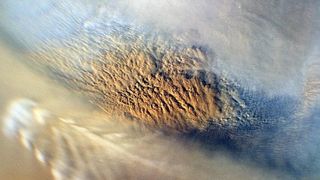7 solar system worlds where the weather is crazy
What's the weather like on other worlds? Expect methane rain, global haboobs and a 10,000-mile-wide hurricane.

Our solar system is home to some weird and wonderful weather, with storms more terrifying in scale than anything in Earth's recorded history. From centuries-old hurricanes on Jupiter to immense winds on Neptune, if you leave Earth you'll be shocked by what you find.
On Mars you will find immense dust storms that cover the entire planet, while Venus has an incredibly thick and fast-moving atmosphere that can form permanent vortices at its poles. On Jupiter and Saturn there are some huge storms — bigger than the diameter of multiple Earths — that have raged for decades or even centuries. On the ice giant Neptune you'll find the fastest winds in the solar system, and within Neptune and Uranus it may rain diamonds.
Thanks to recent missions into space, we have learned more about these fascinating weather systems than ever before. Scientists are also performing long-term studies of weather systems, such as storms erupting from the Sun that can have direct effects on Earth. As we continue to reach into the unknown, who knows what else there is to discover in the solar system?
Jupiter's Great Red Spot: An Earth-sized hurricane

This iconic storm has been raging on Jupiter for centuries, but it may not be around forever. The giant spinning storm is comparable to a hurricane on Earth, although it is considerably larger. It measures about 10,000 miles (16,000 kilometers across), which is roughly 1.3 times the width of our planet. Scientists think its roots go up to 100 times deeper into Jupiter than Earth's oceans. Recent evidence, however, suggests the storm may be shrinking, although it can devour other storms to gain a boost.
That's not the only extreme weather on Jupiter: Its north and south poles have strange arrays of cyclones arranged in a circle, while the intense radiation from the planet bathes some of its moons, such as Io and Europa.
NASA's Juno spacecraft, which entered orbit around Jupiter in 2016, has been collecting incredible data about this gas giant using an array of instruments. This includes a microwave radiometer to measure the deep atmosphere of Jupiter, ultraviolet and infrared cameras to take images of the planet's atmosphere and its aurorae, and JunoCam, which has also been busy snapping visible light images.
Saturn's lightning: 10,000 times more powerful than Earth's

Amazingly we've not only seen lightning on Saturn, but we've also heard it. NASA's Cassini spacecraft, which orbited Saturn from 2004 to 2017, was able to spot lightning on the planet in the daytime, meaning it must have been incredibly intense — some bolts are thought to be 10,000 times more powerful than those on Earth, according to NASA.
By observing radio emissions from the planet, Cassini was also able to 'hear' the storms discharging in the atmosphere. Saturn occasionally develops massive storms that extend more than 190,000 miles (300,000 kilometers), encircling almost the entire planet, while the gas giant's north pole plays host to a weird, permanent hexagon of clouds that extends deep into the planet.
Solar storms: Angry outbursts that knock out power grids

The sun can wreak havoc on our planet. Its solar storms consist of bursts of radiation and charged particles, which can seriously damage satellites that keep a close eye on the sun's activity and prepare for the worst, but occasionally, when a large storm heads our way, satellites and power grids need to be turned off so they can ride it out.
Despite our best efforts, every now and again a violent solar outburst can catch us off guard. In 1859, a powerful solar flare named after astronomer Richard Carrington caused widespread interruptions to global telegraph communications. The Carrington Event of 1859 also sparked incredible aurora displays that were visible as far south as the Caribbean.
In 1989 a solar flare ravaged the electric power transmission from the Hydro Québec generating station, causing a blackout that left six million people without electricity for nine hours.
Solar activity has even been suggested to be a possible cause for the sinking of the Titanic. As new research suggests a solar storm behind the impressive northern light show at the time of the sinking could have disrupted the ship's navigation and communication systems and severely hindered rescue operations.
Venus' vortex: A storm that moves faster than its planet

At the south pole of Venus is a large vortex the size of Europe swirling in the atmosphere. This vortex appears to have been around for a long time and is a result of some strange properties on the planet. The atmosphere on Venus moves faster than the planet, reaching speeds of up to 250 miles (400 kilometers) per hour — 60 times faster than the planet rotates, according to the European Space Agency.
Venus is also the hottest planet in the solar system, but remarkably not the closest to the sun. Its hellishly dense atmosphere blankets the planet and traps heat in a runaway greenhouse effect. As a result, Venusian temperatures can reach 870 degrees Fahrenheit (465 degrees Celsius).
Even the rain on Venus offers no relief from the heinous climate. Corrosive sulfuric acid falls from clouds and evaporates before even reaching the ground due to the extreme surface temperatures.
Neptune's mega wind: Faster than the speed of sound

Neptune, the furthest planet from the Sun, has the fastest winds in the solar system. At the planet's highest altitudes, where methane gives Neptune its blue color, winds can reach speeds of more than 1,300 miles (2,100 kilometers) per hour or 1.6 times the speed of sound. These immense winds also give rise to some large storms, such as the famous "Great Dark Spot" seen by the Voyager 2 probe in 1989.
Scientists are still intrigued as to the cause of this fleeting storm which had vanished by the time NASA's Hubble Space Telescope turned its gaze to Neptune some five years after Voyager 2.
Since then Hubble has kept a watchful eye on Neptune's turbulent storms which rotate clockwise due to the planet's rotation (unlike hurricanes on Earth which are low-pressure systems and rotate counterclockwise). Over the years Hubble has noted the arrival and demise of many Neptunian storms, one of which has recently perplexed scientists.
This particular vortex had been observed sweeping southward toward Neptune's equator, following the path of various storms before it. Though unlike its predecessors this vortex made a sharp U-turn and began to drift back northwards, much to the surprise of researchers.
Martian dust storms: Tornados visible from space

In 2018 a huge dust storm engulfed the surface of Mars, obscuring much of its surface from our view. These storms, known as "haboobs" when they occur on Earth, are fairly regular on Mars, occurring every few years, but this one was particularly large. They are caused by the sun heating the atmosphere of the planet, lifting dust off the ground — although scientists aren't sure how they grow so big, according to NASA. They pose problems for solar-powered rovers on the surface, which rely on the sun's light.
Mars also experiences dust devils — miniature tornadoes that form and move across the surface. This phenomenon is not exclusive to the Red Planet, in fact, they're also observed on Earth.
Dust devils are formed when the ground heats up causing air close to the surface to also warm up and rise. Whilst the air rises it can come into contact with cooler small segments of air higher up which in turn cause the column of air to rotate.
We can see these dust devils due to the dirt they kick up off the ground. They're so visible they can even be seen from space! In 2012, the Mars Reconnaissance Orbiter spotted a colossal Martian dust devil standing 2,600 feet (800 meters) tall and 98 feet (30 meters) wide.
Titan's methane rain: You'd feel every drop

Saturn's largest moon Titan is one of the most enigmatic bodies in the solar system. This Earth-like body hosts liquid on its surface, possesses a truly bizarre climate, and has been intriguing scientists for years.
On Titan methane occasionally falls as rain, after it evaporates from the surface and forms thick clouds. Methane rain on the freezing-cold moon would fall very slowly, due to the low gravity and thick haze, so you'd feel every drop, physicist Rajani Dhingra at the University of Idaho told New Scientist in 2019.
Titan's hydrological cycle (where "hydro" relates to methane not water like on Earth), sculpts the landscape and feeds liquid methane and ethane into huge lakes such as Kraken Mare which is more than 1,000 feet (300 meters) deep.
Sign up for the Live Science daily newsletter now
Get the world’s most fascinating discoveries delivered straight to your inbox.

Jonathan O’Callaghan is a freelance space and science journalist based in the UK. He specialises in covering commercial spaceflight, space exploration and astrophysics, but also reports across a wide range of science, from CRISPR to climate change. Jonathan’s work has featured in Scientific American, Nature, New Scientist, The New York Times, Quanta, Forbes, Wired, and a variety of other publications. He has also made TV and radio appearances as a space expert for the BBC and other organisations.
